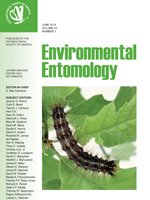In the molecular arms race between aphids and plants, both organisms rely on adaptive strategies to outcompete their evolutionary rival. In the current study, we investigated the difference in elicited defense responses of wheat (Triticum aestivum L.) near-isogenic lines with different Dn resistance genes, upon feeding by an avirulent and hypervirulent Diuraphis noxia Kurdjumov biotype. After measuring the activity of a suite of enzymes associated with plant defense, it became apparent that the host does not recognize the invasion by the hypervirulent aphid because none of these were induced, while feeding by the avirulent biotype did result in induction of enzyme activity. Genomic plasticity in D. noxia may be a likely explanation for the observed differences in virulence between D. noxia bio type SA1 and SAM, as demonstrated in the current study.
How to translate text using browser tools
1 June 2014
Hypervirulent Diuraphis noxia (Hemiptera: Aphididae) Biotype SAM Avoids Triggering Defenses in Its Host (Triticum aestivum) (Poales: Poaceae) during Feeding
Anna-Maria Botha,
N. Francois V. Burger,
Leon Van Eck
ACCESS THE FULL ARTICLE
It is not available for individual sale.
This article is only available to subscribers.
It is not available for individual sale.
It is not available for individual sale.

Environmental Entomology
Vol. 43 • No. 3
June 2014
Vol. 43 • No. 3
June 2014




